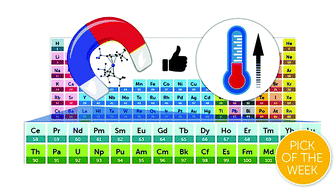当前位置:
X-MOL 学术
›
Chem. Sci.
›
论文详情
Our official English website, www.x-mol.net, welcomes your
feedback! (Note: you will need to create a separate account there.)
Design of high-temperature f-block molecular nanomagnets through the control of vibration-induced spin relaxation
Chemical Science ( IF 7.6 ) Pub Date : 2019/12/02 , DOI: 10.1039/c9sc03133b Luis Escalera-Moreno 1 , José J Baldoví 1 , Alejandro Gaita-Ariño 1 , Eugenio Coronado 1
Chemical Science ( IF 7.6 ) Pub Date : 2019/12/02 , DOI: 10.1039/c9sc03133b Luis Escalera-Moreno 1 , José J Baldoví 1 , Alejandro Gaita-Ariño 1 , Eugenio Coronado 1
Affiliation

|
One of the main roadblocks that still hamper the practical use of molecular nanomagnets is their cryogenic working temperature. In the pursuit of rational strategies to design new molecular nanomagnets with increasing blocking temperature, ab initio methodologies play an important role by guiding synthetic efforts at the lab stage. Nevertheless, when evaluating vibration-induced spin relaxation, these methodologies are still far from being computationally fast enough to provide a useful predictive framework. Herein, we present an inexpensive first-principles method devoted to evaluating vibration-induced spin relaxation in molecular f-block single-ion magnets, with the important advantage of requiring only one CASSCF calculation. The method is illustrated using two case studies based on uranium as the magnetic centre. Finally, we propose chemical modifications in the ligand environment with the aim of suppressing spin relaxation.
中文翻译:

通过控制振动引起的自旋弛豫设计高温 f 块分子纳米磁体
仍然阻碍分子纳米磁体实际应用的主要障碍之一是其低温工作温度。在追求合理策略来设计具有升高阻断温度的新型分子纳米磁体的过程中,从头算方法通过指导实验室阶段的合成工作发挥着重要作用。然而,在评估振动引起的自旋弛豫时,这些方法的计算速度仍然远远不够快,无法提供有用的预测框架。在此,我们提出了一种廉价的第一原理方法,专门用于评估分子f块单离子磁体中振动引起的自旋弛豫,其重要优点是仅需要一次 CASSCF 计算。该方法通过两个以铀为磁中心的案例研究来说明。最后,我们提出对配体环境进行化学修饰,以抑制自旋弛豫。
更新日期:2020-02-13
中文翻译:

通过控制振动引起的自旋弛豫设计高温 f 块分子纳米磁体
仍然阻碍分子纳米磁体实际应用的主要障碍之一是其低温工作温度。在追求合理策略来设计具有升高阻断温度的新型分子纳米磁体的过程中,从头算方法通过指导实验室阶段的合成工作发挥着重要作用。然而,在评估振动引起的自旋弛豫时,这些方法的计算速度仍然远远不够快,无法提供有用的预测框架。在此,我们提出了一种廉价的第一原理方法,专门用于评估分子f块单离子磁体中振动引起的自旋弛豫,其重要优点是仅需要一次 CASSCF 计算。该方法通过两个以铀为磁中心的案例研究来说明。最后,我们提出对配体环境进行化学修饰,以抑制自旋弛豫。











































 京公网安备 11010802027423号
京公网安备 11010802027423号